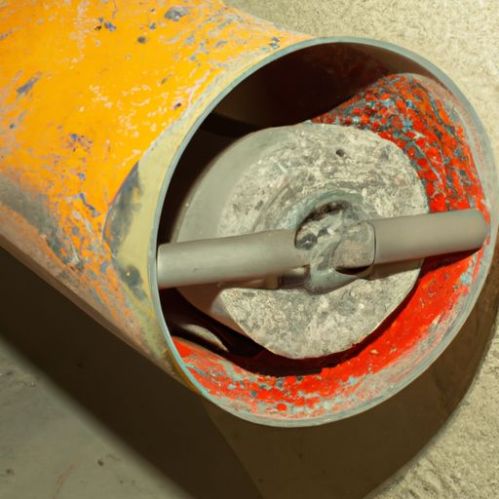Table of Contents
فوائد استخدام أجهزة الختم لفتحات حقن الماء بطبقة الفحم
الأنواع الشائعة لأجهزة منع التسرب لفتحات حقن الماء بطبقات الفحم

تعد فتحات حقن الماء في طبقة الفحم ضرورية لاستخراج غاز الميثان من طبقة الفحم، حيث أنها تسمح بحقن الماء في طبقة الفحم لإطلاق الغاز المحتجز. ومع ذلك، يجب إغلاق هذه الثقوب بشكل صحيح لمنع تسرب المياه وضمان كفاءة عملية الاستخراج. هناك عدة أنواع شائعة من أجهزة الختم المستخدمة في فتحات حقن ماء الفحم، ولكل منها مزاياه وعيوبه.
أحد أجهزة الختم الأكثر استخدامًا لفتحات حقن ماء الفحم هو جهاز التعبئة. العبوات عبارة عن أجهزة قابلة للنفخ يتم إدخالها في الفتحة ثم يتم نفخها لإنشاء ختم. عادة ما تكون مصنوعة من المطاط أو غيرها من المواد المرنة التي يمكن أن تتوسع لملء المساحة داخل الحفرة. تتميز آلات التعبئة بسهولة التركيب والإزالة، مما يجعلها خيارًا شائعًا لإغلاق فتحات حقن مياه الفحم.
نوع شائع آخر من أجهزة الختم لفتحات حقن مياه الفحم هو السدادة الأسمنتية. يتم إنشاء السدادات الأسمنتية عن طريق ضخ الأسمنت في الحفرة والسماح لها بالتصلب، مما يخلق حاجزًا صلبًا يمنع تسرب الماء. تتميز السدادات الأسمنتية بالمتانة وطول العمر، مما يجعلها خيارًا موثوقًا به لإغلاق فتحات حقن الماء بالفحم. ومع ذلك، قد يكون من الصعب إزالتها إذا كانت هناك حاجة إلى إعادة فتح الثقب لأي سبب من الأسباب.
بالإضافة إلى آلات التعبئة وسدادات الأسمنت، هناك أيضًا أختام ميكانيكية يمكن استخدامها لإغلاق فتحات حقن مياه الفحم. عادةً ما تكون الأختام الميكانيكية مصنوعة من المعدن أو المواد الصلبة الأخرى التي يمكن إدخالها في الحفرة ثم توسيعها أو تقليصها لإنشاء ختم محكم. غالبًا ما تُستخدم الأختام الميكانيكية جنبًا إلى جنب مع مواد التعبئة أو المقابس الأسمنتية لتوفير طبقة إضافية من الحماية ضد تسرب المياه.
كل نوع من أجهزة الختم له مزاياه وعيوبه، وسيعتمد اختيار الاستخدام على المتطلبات المحددة من ثقب حقن المياه التماس الفحم. تتميز أدوات التغليف بسهولة التركيب والإزالة، مما يجعلها خيارًا مناسبًا لاحتياجات الختم المؤقتة. تتميز السدادات الأسمنتية بأنها متينة وتدوم طويلاً، مما يجعلها خيارًا موثوقًا به لاحتياجات الختم على المدى الطويل. توفر موانع التسرب الميكانيكية طبقة إضافية من الحماية ضد تسرب المياه، مما يجعلها خيارًا جيدًا لتطبيقات الضغط العالي أو درجات الحرارة العالية.
في الختام، هناك عدة أنواع شائعة من أجهزة الختم التي يمكن استخدامها لإغلاق حقن مياه طبقات الفحم الثقوب. تتمتع كل من أدوات التعبئة والسدادات الأسمنتية والأختام الميكانيكية بمزايا وعيوب خاصة بها، وسيعتمد اختيار ما سيتم استخدامه على المتطلبات المحددة للثقب. يعد الختم المناسب لفتحات حقن مياه الفحم أمرًا ضروريًا لضمان كفاءة عملية الاستخراج ومنع تسرب المياه. من خلال اختيار جهاز الختم المناسب للمهمة، يمكن للمشغلين التأكد من أن عمليات استخراج الميثان من طبقة الفحم الخاصة بهم تتم بسلاسة وكفاءة.
Common Types of Sealing Devices for Coal Seam Water Injection Holes
Coal seam water injection holes are crucial for the extraction of coal bed methane, as they allow for the injection of water into the coal seam to release the trapped gas. However, these holes must be properly sealed to prevent water leakage and ensure the efficiency of the extraction process. There are several common types of sealing devices used for coal seam water injection holes, each with its own advantages and disadvantages.
One of the most commonly used sealing devices for coal seam water injection holes is the Packer. Packers are inflatable devices that are inserted into the hole and then inflated to create a seal. They are typically made of rubber or other flexible materials that can expand to fill the space within the hole. Packers are easy to install and remove, making them a popular choice for sealing coal seam water injection holes.
Another common type of sealing device for coal seam water injection holes is the Cement plug. Cement plugs are created by pumping cement into the hole and allowing it to harden, creating a solid barrier that prevents water from leaking out. Cement plugs are durable and long-lasting, making them a reliable choice for sealing coal seam water injection holes. However, they can be difficult to remove if the hole needs to be reopened for any reason.
In addition to packers and cement plugs, there are also mechanical Seals that can be used to seal coal seam water injection holes. Mechanical seals are typically made of metal or other rigid materials that can be inserted into the hole and then expanded or contracted to create a tight seal. Mechanical seals are often used in conjunction with packers or cement plugs to provide an extra layer of protection against water leakage.
Each type of sealing device has its own advantages and disadvantages, and the choice of which to use will depend on the specific requirements of the coal seam water injection hole. Packers are easy to install and remove, making them a convenient choice for temporary sealing needs. Cement plugs are durable and long-lasting, making them a reliable choice for long-term sealing needs. Mechanical seals provide an extra layer of protection against water leakage, making them a good choice for high-pressure or high-temperature applications.
In conclusion, there are several common types of sealing devices that can be used to seal coal seam water injection holes. Packers, cement plugs, and mechanical seals each have their own advantages and disadvantages, and the choice of which to use will depend on the specific requirements of the hole. Proper sealing of coal seam water injection holes is essential to ensure the efficiency of the extraction process and prevent water leakage. By choosing the right sealing device for the job, operators can ensure that their coal bed methane extraction operations run smoothly and efficiently.
